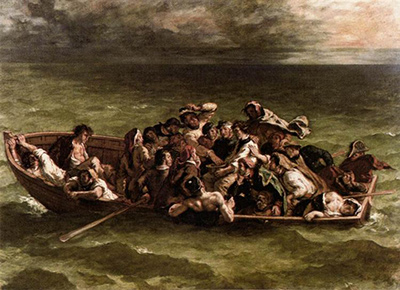French painter Eugène Delacroix was inspired to create this painting by Lord Byron's poem Don Juan in which survivors of a shipwreck draw lots to decide who must sacrifice his life to feed the others.
Elements of the poem that can be found in the painting are a dark and stormy sky and the haggard castaways, although Delacroix painting is not a minute representation of the scene as described in the poem.
Delacroix’ technique when painting the Shipwreck of Don Juan included applying transparent layers of oil to his œuvre between sessions.
Certain details of the painting, such as touches of light added to the sea, also make it apparent that Delacroix returned to refine his painting at a later stage. The original painting was released only posthumously and is currently on display at the Louvre in Paris.
Eugène Delacroix, born in 1798 in Charenton-Saint-Maurice, France, was one of the epoch's most influential Romantic painters. A large part of his artwork is inspired by literary creations by authors such as William Shakespeare, Johann Wolfgang von Goethe or Walter Scott.
He felt a special kinship towards Lord Byron, whose passion for the forces of nature he shared.
Among Delacroix’ artistic role models are Dutch Baroque painter Rubens and various painters of the Renaissance era. A trademark of Delacroix’ work is his expressive brush-stroke, a technique that is also reflected in the Shipwreck of Don Juan.
This technique as well as his knowledge about the optical effects achieved with colour served as an inspiration to the Impressionist movement lead by painters such as Claude Monet.
Other paintings by Eugène Delacroix include Liberty Leading the People, The Massacre at Chios and Greece on the Ruins of Missolonghi. Perhaps his most famous painting, Liberty Leading the People, is based on the July Revolution in France in 1830.
The figure of Marianne who appears as Liberty in the painting has evolved to become a national symbol of the Republic of France. The painting is currently on display at the Louvre.
